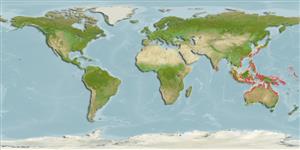Environment: milieu / climate zone / depth range / distribution range
Ecologia
marino demersale; distribuzione batimetrica 2 - 20 m (Ref. 90102). Subtropical
Western Pacific: Japan to Australia.
Size / Peso / Age
Maturity: Lm ? range ? - ? cm
Max length : 10.0 cm SL maschio/sesso non determinato; (Ref. 48637)
Spine dorsali (totale): 6 - 7; Raggi dorsali molli (totale): 10; Spine anali 1; Raggi anali molli: 9. Characterized by overall whitish or pale grey to yellow body color; dark brown to blackish stripe from eye to middle of caudal fin base; head with orange to bluish spots; fins mainly pale and unmarked; first dorsal fin much taller than second dorsal fin; united pelvic fins, frenum present; longitudinal scale series 90-95; head without scales; greatest depth of body4.5-5.0 in SL; rounded caudal fin, about equal to head length (Ref. 90102).
Lives in muddy coastal bays and estuaries (Ref. 48637). Also found in sheltered bays and lagoons in 2-20 m (Ref 90102).
Life cycle and mating behavior
Maturità | Riproduzione | Deposizione | Uova | Fecundity | Larve
Masuda, H., K. Amaoka, C. Araga, T. Uyeno and T. Yoshino, 1984. The fishes of the Japanese Archipelago. Vol. 1. Tokai University Press, Tokyo, Japan. 437 p. (text). (Ref. 559)
IUCN Red List Status (Ref. 130435)
Threat to humans
Harmless
Human uses
Informazioni ulteriori
Nomi ComuniSinonimiMetabolismoPredatoriEcotossicologiaRiproduzioneMaturitàDeposizioneSpawning aggregationFecundityUovaEgg development
BibliografiaAcquacolturaProfilo di acquacolturaVarietàGeneticaElectrophoresesEreditarietàMalattieElaborazioneNutrientsMass conversion
CollaboratoriImmaginiStamps, Coins Misc.SuoniCiguateraVelocitàModalità di nuotoArea branchialeOtolithsCervelliVista
Strumenti
Special reports
Download XML
Fonti Internet
Estimates based on models
Preferred temperature (Ref.
123201): 24.9 - 29.3, mean 28.6 °C (based on 2191 cells).
Phylogenetic diversity index (Ref.
82804): PD
50 = 0.5020 [Uniqueness, from 0.5 = low to 2.0 = high].
Bayesian length-weight: a=0.00708 (0.00333 - 0.01504), b=3.09 (2.92 - 3.26), in cm total length, based on LWR estimates for this (Sub)family-body shape (Ref.
93245).
Trophic level (Ref.
69278): 3.4 ±0.4 se; based on size and trophs of closest relatives
Resilienza (Ref.
120179): Alto, tempo minimo di raddoppiamento della popolazione meno di 15 mesi (Preliminary K or Fecundity.).
Fishing Vulnerability (Ref.
59153): Low vulnerability (10 of 100).
